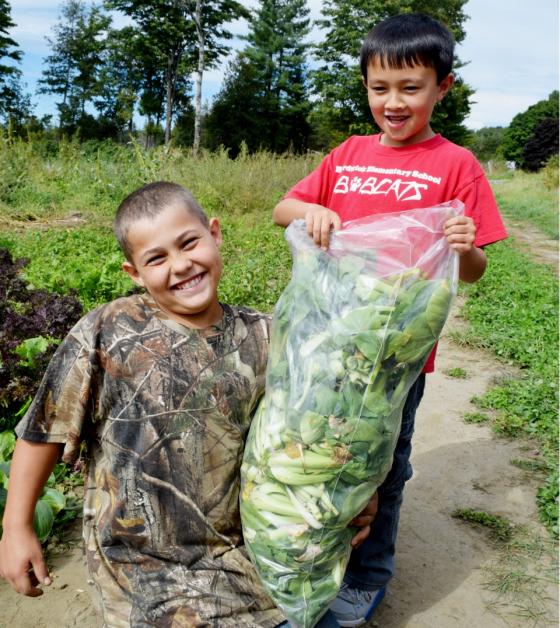Posted March 17, 2022 at 10:36am by Anonymous (not verified)
Farm to School: Good for kids, economy & communities

Written by Betsy Rosenbluth
Vermont has much to celebrate as a national leader in the Farm to School movement and it hasn’t happened by accident. Nearly a decade ago, in 2007, Vermont was one of the first states to pass a Farm to School bill. That legislation has supported more than 100 schools through grants and technical assistance since then, affecting the lives of more than 30,000 students across the state. Last year, Vermont led the nation again by creating the first state investment in universal school meals, an opportunity to provide more students with access to healthy, local food.
There has been so much good work and success around Farm to School for a fairly straightforward reason: it works! Here’s how (and how it can be even better):
Farm to School is good for our kids.
Currently, 1 in 4 Vermont teens are obese or overweight. This creates a much higher risk for long term health problems. In fact, chronic diseases are projected to cost Vermont over $2 billion in health care costs this year alone! Farm to School engages students in learning about nutrition and good food choices through hands on experiences that teach not only where our food comes from, but what it does for our bodies. Farm to School also increases participation in school nutrition programs and ensures all kids have access and exposure to fresh, local food in the cafeterias. That means more kids, especially those coming from homes struggling to put food on their own tables, are eating nutritious meals that help them thrive, and children carry these experiences and healthy habits with them as they grow.
Farm to School is good for the economy.
For every dollar Vermont schools spend on purchasing local food, an additional 60¢ goes back into the local economy. Vermont schools spent almost a million dollars on local food in the 2013-2014 school year. That was 5.6% of the total money spent on all food that year. If schools doubled the amount of local food they purchased, it would contribute $2.1 million to our Vermont economy.
We’re on the right path to that goal: The recent USDA Farm to School Census found that 51% of Vermont school districts plan to purchase more local foods in the future.
Additionally, by exposing all youth to Vermont foods, Farm to School is educating the next generation of food consumers and shaping their future buying habits. When more Vermonters demand local food in the years to come, the marketplace will respond with more local food that is produced and distributed by Vermonters, for Vermonters.
Farm to School is good for our communities.
Farm to School is one of those rare win-win investments in the future of Vermont children and local farming communities. By simply introducing students, parents, and teachers to the working farms and farmers in their areas, it strengthens our community bonds. The Farm to School movement is also being applied to preschools, beginning these critical connections even earlier.
More work to be done
Yet for all the success of Farm to School in Vermont -- its real and potential benefits -- there is so much more to be done. And there’s real reason for concern: Since Vermont passed the 2007 legislation, state funding for Farm to School has steadily eroded. In fact, it has shrunk by 60%. Yet these small state grants to schools and communities can be the seeds from which a robust Farm to School culture grows.
In response to this concern, the Vermont Farm to School Network is working to restore and expand the state’s investment in Farm to School by reaching legislators and school leaders to demonstrate how such an investment makes sense for our kids, communities, farms, and economy.An expansion of funding for Farm to School will better meet school demand, invest in school nutrition to serve healthy, local foods, and expand farm to school programs to early care and education.
These efforts will help the Farm to School Network reach their overarching goals:
· By 2025, 75% of Vermont schools will lead the cultural shift to a values-based food system that engages 75% of our students in integrated food system education, community-based learning,nourishing universal meals, and the experience of self-efficacy
· By 2025, 75% of Vermont schools will purchase at least 50% from a socially just and environmentally and financially sustainable regional food system.
These goals sync well with Vermont’s Farm to Plate food system plan goals to increase local food consumption, institutional consumption, and food literacy and to decrease food-related health problems and food insecurity.
Visit the Vermont Farm to School Network website to learn more about the work underway to restore and expand the state’s investment in Farm to School.
